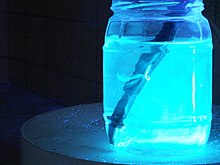Aesculin
| Structural formula | |||||||||||||||||||
|---|---|---|---|---|---|---|---|---|---|---|---|---|---|---|---|---|---|---|---|

|
|||||||||||||||||||
| General | |||||||||||||||||||
| Surname | Aesculin | ||||||||||||||||||
| other names |
|
||||||||||||||||||
| Molecular formula | C 15 H 16 O 9 | ||||||||||||||||||
| Brief description |
bitter tasting needles |
||||||||||||||||||
| External identifiers / databases | |||||||||||||||||||
|
|||||||||||||||||||
| properties | |||||||||||||||||||
| Molar mass | 340.28 g mol −1 | ||||||||||||||||||
| Physical state |
firmly |
||||||||||||||||||
| density |
1.36 g cm −3 (20 ° C) |
||||||||||||||||||
| Melting point |
204-206 ° C |
||||||||||||||||||
| solubility |
poorly soluble in water (1.7 g l −1 at 20 ° C) |
||||||||||||||||||
| safety instructions | |||||||||||||||||||
|
|||||||||||||||||||
| As far as possible and customary, SI units are used. Unless otherwise noted, the data given apply to standard conditions . | |||||||||||||||||||
Aesculin is a glucoside that occurs naturally in the bark and seeds of the horse chestnut ( Aesculus hippocastanum ); it is also found in daphnin , the dark green resin of the common daphne ( Daphne mezereum ).
properties
Aesculin is one of the 6,7-dihydroxy coumarins . Like other coumarins , the substance fluoresces blue under ultraviolet light, for example a wavelength of 366 nm. This fluorescence in watery extracts of horse chestnut bark exposed to sunlight was reported as early as the 19th century. The German chemist Paul Krais (1866–1939) investigated this effect by adding aesculin-containing extracts of horse chestnut to wool and flax, thereby achieving an optical brightening .
use
Laboratory diagnostics
Aesculin is used in microbiology to identify certain bacteria, especially enterococci . Enterococci have the property of hydrolyzing esculin to glucose and esculetin . In the presence of iron (III) ions, esculetin forms an olive-green to black complex . This detection is known as esculin cleavage or esculin hydrolysis.
Medical application
Aesculin is sometimes used as a vasoprotector in medicines .
Individual evidence
- ↑ esculin . In: Merck's Warenlexikon . 3rd ed. 1884 ff., P. 3 f.
- ↑ a b Entry on 6,7-dihydroxycoumarins. In: Römpp Online . Georg Thieme Verlag, accessed on February 7, 2019.
- ^ Carl L. Yaws: Thermophysical Properties of Chemicals and Hydrocarbons . William Andrew, 2014, ISBN 978-0-323-29060-9 , pp. 330 ( limited preview in Google Book search).
- ↑ Cynthia A. Challener: Chiral Drugs . Routledge, 2017, ISBN 978-1-351-80804-0 ( limited preview in Google Book Search).
- ↑ a b data sheet Esculin hydrate from Sigma-Aldrich , accessed on February 7, 2019 ( PDF ).
- ↑ JC Poggendorf (Ed.): Annalen der Physik , Vol. 4, Verlag JA Barth, Leipzig 1854. P. 313.
- ^ HJ Meyer (Ed.): New Konversations-Lexikon - A dictionary of general knowledge , Vol. 6, Verlag Bibliographisches Institut, Hildburghausen 1863. S. 936.
- ^ University of Jena: Optical brighteners (history and material groups).
- ↑ Esculin . Drugs.com. Retrieved June 11, 2016.
